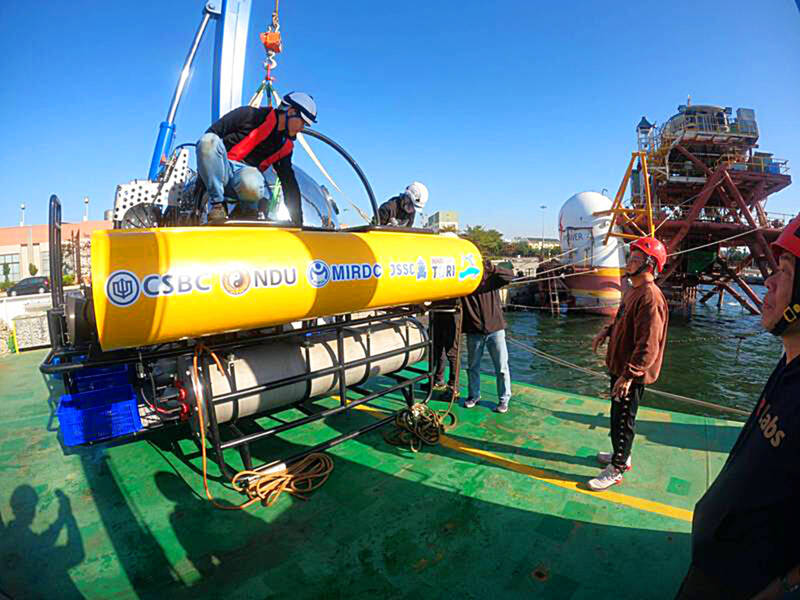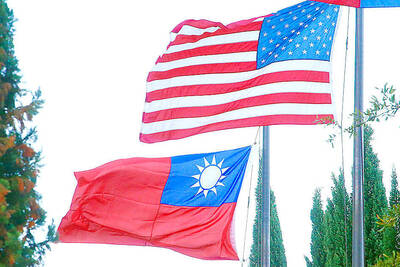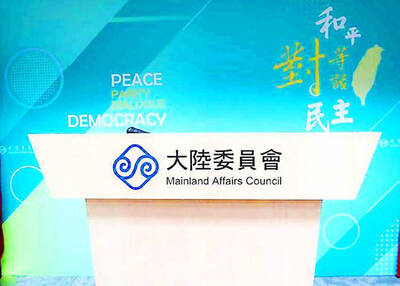Five national universities are expected to establish six research centers in areas of national focus as part of the Ministry of Education’s goal of attracting international talent and supporting local academics to improve Taiwan’s academic competitive edge internationally.
The centers will begin attracting students in the upcoming semester, starting in August, the ministry said.
The project is expected to cost about NT$300 million (US$10.02 million) annually and each center developed would receive NT$50 million in funding, Department of Higher Education Director-General Liao Kao-hsien (廖高賢) said.

Photo courtesy of the National Sun Yat-sen University Underwater Vehicle R&D Center
National Taiwan University President Chen Wen-chang (陳文章) said the university would establish two centers focused on artificial intelligence (AI) and advanced biomedicine.
The university also plans to invest NT$5 million per year, Chen added.
National Tsing Hua University Vice President Tai Nien-hua (戴念華) said that their university’s center would specialize in quantum technology, a crucial part of future technological development, with applications spanning physics, materials science, information engineering and mechanical engineering.
National Cheng Kung University President Shen Meng-ru (沈孟儒) said the university’s center would focus on medicine, electronics and engineering, especially on adapting cutting-edge technology for clinical use.
National Sun Yat-sen University President Lee Chih-peng (李志鵬) said that their center would concentrate on marine technology development, as it hopes to bring the nation’s marine technology up to par with the EU, the US and Japan, and open a new market for Taiwanese industries.
National Yang Ming Chiao Tung University President Lin Chi-hung (林奇宏) said that the university’s center would specialize in AI development.
A deeper understanding of cloud and edge AI applications would enable better utilization of technology for industrial development, while also ensuring that Taiwan leads future developmental trends, he said.
Separately, the ministry said it would be providing additional subsidies to departments in twelve universities with exceptional performance.
To encourage universities to work toward being listed among the world’s top 100 universities, the ministry is providing NT$20 million in subsidies to departments that are mentioned in the top 50 on EQ, THE or ESI rankings, it said.
Departments and schools listed from 51 to 100 are also eligible to receive NT$10 million in additional funding.
Chen said the subsidies would help departments advance further in the world rankings.
On the other hand, Tai said that the move, despite its good intentions, was not without its blind spots, and urged the ministry to allow the universities to participate in deciding the criteria.

Taiwan is projected to lose a working-age population of about 6.67 million people in two waves of retirement in the coming years, as the nation confronts accelerating demographic decline and a shortage of younger workers to take their place, the Ministry of the Interior said. Taiwan experienced its largest baby boom between 1958 and 1966, when the population grew by 3.78 million, followed by a second surge of 2.89 million between 1976 and 1982, ministry data showed. In 2023, the first of those baby boom generations — those born in the late 1950s and early 1960s — began to enter retirement, triggering

One of two tropical depressions that formed off Taiwan yesterday morning could turn into a moderate typhoon by the weekend, the Central Weather Administration (CWA) said yesterday. Tropical Depression No. 21 formed at 8am about 1,850km off the southeast coast, CWA forecaster Lee Meng-hsuan (李孟軒) said. The weather system is expected to move northwest as it builds momentum, possibly intensifying this weekend into a typhoon, which would be called Mitag, Lee said. The radius of the storm is expected to reach almost 200km, she said. It is forecast to approach the southeast of Taiwan on Monday next week and pass through the Bashi Channel

NO CHANGE: The TRA makes clear that the US does not consider the status of Taiwan to have been determined by WWII-era documents, a former AIT deputy director said The American Institute in Taiwan’s (AIT) comments that World War-II era documents do not determine Taiwan’s political status accurately conveyed the US’ stance, the US Department of State said. An AIT spokesperson on Saturday said that a Chinese official mischaracterized World War II-era documents as stating that Taiwan was ceded to the China. The remarks from the US’ de facto embassy in Taiwan drew criticism from the Ma Ying-jeou Foundation, whose director said the comments put Taiwan in danger. The Chinese-language United Daily News yesterday reported that a US State Department spokesperson confirmed the AIT’s position. They added that the US would continue to

The number of Chinese spouses applying for dependent residency as well as long-term residency in Taiwan has decreased, the Mainland Affairs Council said yesterday, adding that the reduction of Chinese spouses staying or living in Taiwan is only one facet reflecting the general decrease in the number of people willing to get married in Taiwan. The number of Chinese spouses applying for dependent residency last year was 7,123, down by 2,931, or 29.15 percent, from the previous year. The same census showed that the number of Chinese spouses applying for long-term residency and receiving approval last year stood at 2,973, down 1,520,